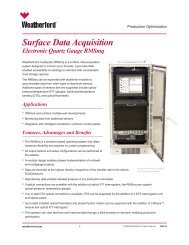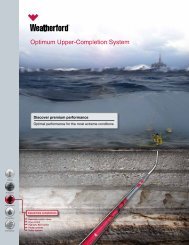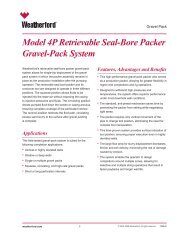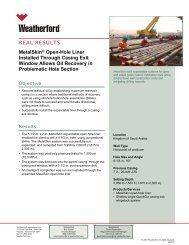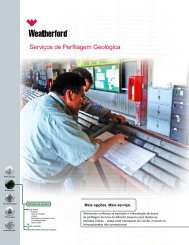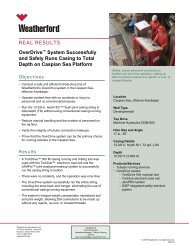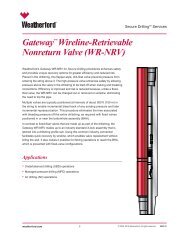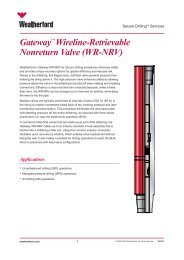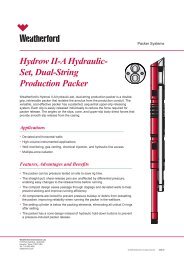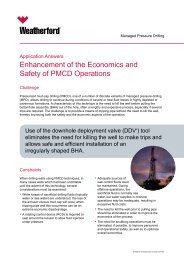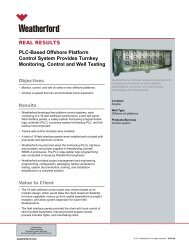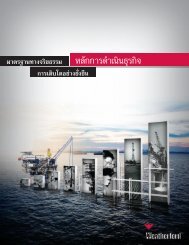Drilling with casing cuts top-hole time, sets length record
Drilling with casing cuts top-hole time, sets length record
Drilling with casing cuts top-hole time, sets length record
Create successful ePaper yourself
Turn your PDF publications into a flip-book with our unique Google optimized e-Paper software.
CASING teChNoloGy<br />
Fig. 3. Torque rings were used to increase torque transmission<br />
capacity of the standard <strong>casing</strong> during drilling operations.<br />
Pipe<br />
Coupling<br />
FCR ring<br />
complished <strong>with</strong>out delay and according to plan. The system<br />
proved to be well-suited to drilling <strong>with</strong> the 13⅜-in. <strong>casing</strong><br />
string. The torque rings installed in the “J” area of the coupling<br />
to provide extra torque resistance sustained the expected medium-<br />
to-medium-high drilling torque.<br />
The 13⅜-in. x 17½-in. premium <strong>casing</strong> bit drilled from<br />
685.73 ft to 3,296 ft for 2,610.36 ft of drilled depth. The average<br />
on-bottom ROP was 285.12 ft/hr. As a result, the section was<br />
drilled to TD in 16.27 hr, including connection <strong>time</strong>. <strong>Drilling</strong><br />
the 3,296-ft section set a world <strong>record</strong> <strong>length</strong> for drilling <strong>with</strong><br />
13⅜-in. <strong>casing</strong> for both Apache and Weatherford.<br />
The high-viscosity sweeps pumped <strong>with</strong> every joint ensured<br />
sufficient <strong>hole</strong> cleaning <strong>with</strong> the high ROP and increased cuttings<br />
volume. Circulation losses were mitigated by the “smear<br />
effect” mechanism produced by <strong>casing</strong> drilling, and mud returns<br />
were observed over the entire interval.<br />
LESSONS LEARNED<br />
Surveys taken afterward when tripping into <strong>hole</strong> <strong>with</strong> a 12¼in.<br />
rotary steerable assembly <strong>record</strong>ed inclinations in the 13⅜in.<br />
<strong>casing</strong>, growing from 1° at 685.73 ft to 3° at 1,640.5 ft and to<br />
9.15° inclination at 3,185.85 ft. This equates to an average build<br />
rate of about 0.32° per 98.43 ft (30 m). Three main factors have<br />
contributed to building angle on Barberry-1. First is the high<br />
flow rate and potential for some formation intervals to wash<br />
out. While the critical annular velocity was 221 ft/min at 1,400<br />
gpm, annular velocity between the <strong>casing</strong> and a gauge bore<strong>hole</strong><br />
(17½-in.) was 269 ft/min.<br />
High WOB could have effectively tilted the bit to deflect<br />
the wellbore from vertical. This effect is multiplied where<br />
bore<strong>hole</strong> wall erosion is present. Building angle could also be<br />
due to the relationship of the outer diameter of the <strong>casing</strong> bit<br />
to outer diameter of the <strong>casing</strong>, combined <strong>with</strong> high flow rate<br />
and bit weight.<br />
Changes in the relationship between <strong>casing</strong> bit and <strong>casing</strong><br />
OD were not achievable on the Barberry-1, because internal<br />
and external dimensional limitations of the 13⅜-in. <strong>casing</strong> bit<br />
prevent a design <strong>with</strong> a final bore<strong>hole</strong> diameter any smaller<br />
than 17½ in. Advances in <strong>casing</strong> bit technology now allow a<br />
smaller final outer diameter of 16 in. Along <strong>with</strong> decreased<br />
flow rates and WOB, the new design should reduce the build<br />
tendency.<br />
Pipe<br />
Torqued up connection when<br />
run in well in vertical position<br />
Fig. 2. The Weatherford <strong>top</strong> drive <strong>casing</strong> running and drilling<br />
system was already on the rig for standard drilling operations<br />
when the decision was made to implement DwC operations.<br />
CASING DRILLING SOLUTION<br />
Success in drilling the troublesome <strong>top</strong>-<strong>hole</strong> section of the<br />
Barberry-1 demonstrated the effectiveness of <strong>casing</strong> drilling<br />
methods relative to conventional drill pipe operations. The capabilities<br />
of <strong>casing</strong> drilling enabled by a unique <strong>top</strong> drive running<br />
and drilling system resulted in a significant reduction in rig<br />
<strong>time</strong> due to problem mitigation and operational efficiency.<br />
BUDI UTAMA graduated <strong>with</strong> a BS in Petroleum<br />
Engineering from universitas Pembangunan nasional in<br />
Indonesia. He joined Weatherford Indonesia in 2006 as a<br />
managed pressure field engineer. He transferred to the<br />
<strong>Drilling</strong> <strong>with</strong> Casing department as an applications<br />
engineer and presently works in onshore planning and<br />
assists in drilling <strong>with</strong> <strong>casing</strong> field applications.<br />
RICHARD READING began working in the oilfield in 1992<br />
<strong>with</strong> ODE on Barrow Island for two years, for WaPET in<br />
Western australia. In 2007, he went to work for apache<br />
Energy as a drilling supervisor on the Van Gogh project.<br />
after several months in this position, he moved to the<br />
Perth office as a workover coordinator while pursung a<br />
degree from the university of Western australia in oil<br />
and gas engineering. upon completing his degree, he accepted his<br />
present position as a drilling engineer <strong>with</strong> apache in the Perth office.<br />
Article copyright © 2012 by Gulf Publishing Company. All rights reserved. Printed in U.S.A.<br />
60 january 2012 / WorldOil.com<br />
Not to be distributed in electronic or printed form, or posted on a website, <strong>with</strong>out express written permission of copyright holder.



